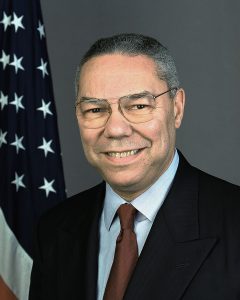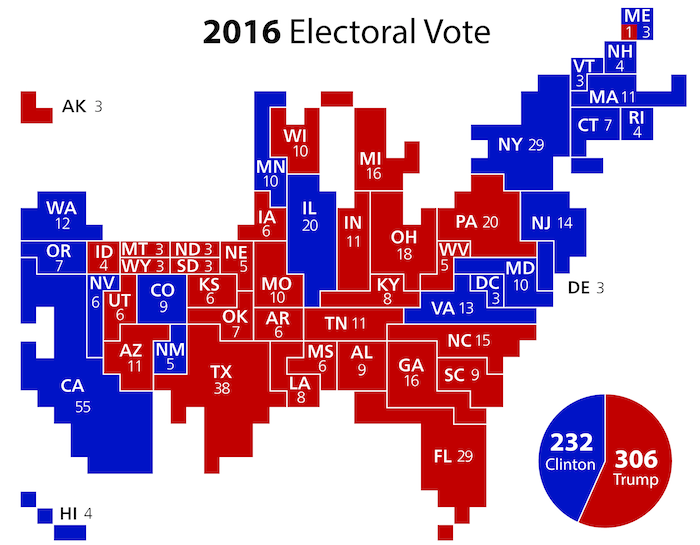We weren't alive in 1836 or 1872, so the election cycle of 2016 was the craziest in our lifetime. The nation voted on November 8, 2016 and Donald Trump defeated Hillary Clinton in assumed delegates 306 - 232, while losing by a large margin in the popular vote. At press time, Hillary Clinton had a 2.1 percentage point lead in the popular vote count, 48.1% to 46.0%.
Almost immediately, a large campaign to get electors to become faithless, or to switch their vote from Donald Trump commenced. Celebrities recorded videos, other celebrities offered to pay electors to switch votes, and editorials on eliminating the electoral college or being a faithless elector showed up in major publications (see here, here, here, and here). A petition encouraging electors to elect Hillary Clinton garnered 5 million votes. Electoral voters received deluges of mail and email (including death threats). A previous candidate and Harvard professor, Larry Lessig, predicted at least 20 faithless electors.
When all was said and done, however, there were between 7 and 10 faithless electors. 5 electoral voters successfully switched their votes from Hillary Clinton, while 2 voters switched votes from Donald Trump. Another 3 electors attempted to change votes from Clinton but were ultimately unsuccessful. Between Trump and Clinton, the final count was 304-227, giving Donald Trump the necessary 270 electoral votes.
What Is the Electoral College?
The electoral college is the body which actually elects the president and vice president in the United States. States are awarded electoral votes in proportion to their population (out of a total pool of 538 electors). States decide how to allocate those votes. A majority of states are 'winner-takes all', awarding all votes to the popular vote winner.
This system also leads to situations like we saw this year.
Depending on the geographic distribution of votes, the popular vote won't necessarily go to the popular vote leader. In fact, it's theoretically possible to win the presidency with only 22-23% of the popular vote.
Because of the winner-take-all nature of most states, there is no use in 'running up the score' in states. Geographically distributed movements - as we saw this year - can beat movements with large margins in individual states. In short: it's usually better to barely win a bunch of states.
While eliminating the electoral college would require a constitutional amendment, some states are trying to change the system to a popular vote. The National Popular Vote Interstate Movement aims to sign up enough states to gain 270 electoral votes to award to the popular vote winner. Currently, ten states and Washington, D.C. have enacted the legislation and represent just short of 31% of the electoral college. If enough states sign on, state signatories change how their electoral vote is allocated in future elections.
What Did Faithless Electors Do in 2016?
Electors are supposed to cast their votes as their state mandates. A sideshow most years, faithless electors are only common when a candidate dies before the electoral college votes.
Let's toss out years when a candidate died before the electoral college voted. Let's also toss out the strange circumstances of 1896 where William Jennings Bryan ran on two party tickets and 27 electors faithless voted for a different vice president. Those elections aside, we saw the most faithless electors since 1836's 23.
7 faithless electors were able to have their faithless votes registered, 2 others were replaced, and one voter switched his vote on the second ballot. 2 of the successful faithless electors were Donald Trump electors, while the other 8 (5 successful) were Hillary Clinton electors. Congress eventually certified the vote, too – although you can find many editorials arguing Democrats should overturn the results.
What Happened in Maine?
In Maine, electoral voter David Bright pledged to vote for Hillary Clinton. On his first ballot, however, he voted for Bernie Sanders - and on the second ballot voted for Hillary Clinton. About his vote he stated: "I can’t do anything to change the results of the election this year. But perhaps by encouraging these idealistic voters to stick around, I can change the results of elections to come.”
What Happened in Minnesota?
In Minnesota, faithless elector Muhammad Abdurrahman attempted to cast an electoral vote for Barry Sanders although pledged to Hillary Clinton. A faithless elector in Minnesota in 2004 saw Abdurrahman replaced to cast a vote for Clinton.
Of the incident, Muhammad said that state law said he had to follow the state vote but the constitution does not.
What Happened in Colorado?
In Colorado, faithless elector Michael Baca cast a vote for John Kasich though pledged to Hillary Clinton. After an emergency court motion and some political maneuvering (including three electors claiming they signed their voting oaths under distress) a replacement voted for Hillary Clinton and running mate Tim Kaine.
What Happened in Washington?
After those three foiled faithless votes, Washington State saw the first successful attempt with a whopping four faithless electors. They were Esther John, Levi Guerra, and Bret Chiafalo (who voted for Colin Powell) and Robert Satiacum (who voted for Faith Spotted Eagle). Vice Presidential votes went to Maria Cantwell, Susan Collins, Elizabeth Warren and Winona LaDuke.
What Happened In Texas?
Texas saw two faithless electors in 2016. One was presumably Chris Suprun, who likely cast a vote for John Kasich. Electoral votes in Texas are anonymous, so the second voter is unknown - but he or she voted for Ron Paul. Vice Presidential votes went to Mike Pence and Carly Fiorina.
What Happened in Hawaii?
If the day wasn't interesting enough already, there was a faithless elector in Hawaii at the end of the night. David Mulinex voted for Bernie Sanders - the first Sanders electoral vote that officially stuck. He also cast the second vice presidential vote for Elizabeth Warren.
Mulinex said of his decision, "We shouldn't have electors. The votes of the people should be making the decision. The Electoral College is outdated. Maybe it worked in 1789 when almost nobody could read or write. Maybe it made sense then -- but we are way past that.".

Had the electoral college failed to elect Trump, Colin Powell would have been eligible for vote in the House of Representatives.
What Were the Final, Official Electoral Vote Tallies in 2016?
Seven faithless electors had their votes certified, and one of them still cast a vote for the pledged Vice President. Another three changed on a re-vote or didn't count.
Here's the official count after the most eventful electoral college vote of our lifetime, with the pledged votes in parentheses and additional color in square brackets.
2016 Presidential Electoral Votes:
- Donald Trump - 304 (306)
- Hillary Clinton - 227 (232)
- Colin Powell - 3
- Bernie Sanders - 1 [2 failed votes]
- John Kasich - 1 [1 failed vote]
- Ron Paul - 1
- Faith Spotted Eagle - 1
2016 Vice President Electoral Votes:
- Mike Pence - 305 (306)
- Tim Kaine - 227 (232)
- Elizabeth Warren - 2
- Susan Collins - 1
- Carly Fiorina - 1
- Winona LaDuke - 1
- Maria Cantwell - 1

